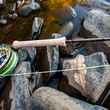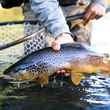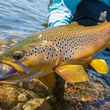There’s something of a cult movement in Idaho (no, not that one). It’s centered around the state’s native char, and its members are tight-lipped and secretive. And for good reason.
Every summer — later is usually better — these clandestine fly fishers venture into the state’s plentiful hinterlands on stealth missions to find and catch big bull trout. There are only a couple of unwritten rules to this endeavor. First, you really don’t talk about it, particularly among folks who tend to do a lot of talking. Second, if you ever do talk about it, place names are usually substituted for names that sound absolutely miserable.
To wit, Cottonwood Creek might, in the wrong company, suddenly become Thistle Creek. Spruce Creek might go by the moniker Rattlesnake Gulch. Or, better yet, Moose Creek is referred to as Poison Creek. Clearly, there are no fish in Poison Creek.
I just spent a couple of days on a bull trout mission. And, while I did stumble across a few fish where, in the past, I’ve hooked a few dozen in a day, for the most part, the trip to Big Mosquito Creek was a bust. Such a bust that I soldiered on and looked for bulls in other waters where they’ve been rumored to turn up now and then.
Honestly, and this isn’t secret information, any angler can set out on a bull trout fact-finding mission in Idaho if he or she understands the basics of the state’s hydrology. And, yes, it’s perfectly legal to target and catch bull trout in Idaho (contrary to the belief of some, who insist that the fish’s protected status makes it illegal to chase) so long as they are immediately returned to the water. In neighboring Montana, bull trout can only be targeted in certain watersheds, and must be released unharmed if they are “incidentally” caught in others.
Say what you will, but if you’re casting a weighted, size 4 Circus Peanut with a sink-tip line in a big, backcountry river in Montana, I’m pretty sure you’re not going after cutthroats. Splitting hairs? Sure. At least we’re honest about it here in the Gem State.
After the generally lackluster showing from the bulls in Big Mosquito Creek, I ventured a bit farther afield, using my geographical appreciation of Idaho’s plumbing. And it’s simple, really. If a river or a stream flows into a river or stream that eventually flows into the Snake River drainage below Shoshone Falls, there’s a realistic chance that bull trout might show up. Yes, that’s a very big generalization, but if I boil it down much more, the talky-talky crowd will be inspired to pull out their dog-eared copies of DeLorme’s Atlas and Gazetteers and start following blue lines into the state’s unblemished beating heart.
Big fish will do that to people.
And, for whatever reason, this year’s bull-trout odyssey didn’t pan out like I hoped. I’m not deterred. Just a bit bothered. Sort of the fishing equivalent of, “I’m not mad. I’m just disappointed” — disappointed by my unfailing ability to find very healthy populations of char in Idaho’s backcountry. But, sadly, I keep finding the wrong char.
Non-native brook trout are a scourge upon the West. From New Mexico to Montana, these invasive fish — which hail from the upper Midwest and the Eastern Seaboard from Georgia to Labrador — are a reminder that the United States was settled from the east to the west. And when European-American settlers gentrified the Rockies and points beyond, they clearly pined for the familiarity of Appalachia. So, at the first opportunity, they sent for their beautifully painted brook trout and proceeded to forever tarnish the waters of the West.
Am I bitter? You’re damned right I’m bitter. Thankfully, those settlers also brought Kentucky bourbon, because all these accursed brookies are enough to make a guy need a stiff drink or two.
Since the late 1800s brookies were first brought to the Rockies and beyond, the impacts on our native fish have been acute. Brookies were first introduced to Colorado in 1872, and stocking records show they were introduced into several streams in the Sierra-Nevada range of California as early 1871. They turned up in stocking reports from New Mexico, Nevada, Utah, Washington and Oregon not long after that. By 1900, brookies were widespread in the West. Today, in part because of the brook trout invasion, our native cutthroat trout now occupy about 10 percent of their historic habitat. And there are several examples where invasive brook trout have displaced native bull trout, either by outcompeting them for resources, or by mingling with them during the spawning season and diluting their presence by hybridization.
Now, for clarity, I’m not “reporting” that my anecdotal and generally unsuccessful fact-finding mission for bull trout in Idaho means that bull trout are in trouble in Idaho. Far from it. Honestly, since fisheries managers developed an appreciation for native fish and began to understand the roles that native trout and char play in a healthy environment, the efforts to protect and restore bull trout populations in my state are admirable. Truth be told, I hit a handful of waters for the first time that met the most basic criteria (that hydrology thing, remember?). That I only found brook trout isn’t really surprising.
A guy can hope. And I hoped for bull trout.
You know what they say, though. “Hope in one hand and …” Well, you get the idea.
And, when you’re on the prowl for big, wild char in some of the most stunning country in the Lower 48, the last thing you want to do is come tight to a six-inch brookie that fought over your fly with a dozen other six-inch brookies.
That, of course, is the angler’s most distasteful critique of brook trout. Here, where they’re not native, they eat themselves out of house and home. A mature brookie in most western waters might be four years old and be just seven inches long. In other words, they’re friggin’ small. In that same water minus brook trout, a bull trout on its late-summer migration might top 20 inches.
And, in some waters, there might be a dozen bulls that size, clustered together and willing to chase a fly. For sight-casting fly fishers, bull trout, because they thrive in the cold, clear waters of the Northwest backcountry, are to be treasured.
That’s why there’s a bull trout cult to begin with.
































Comments
Mico replied on Permalink
Here in the southeast rainbows and browns are invasive and have outcompeted and displaced brook trout over most of their native range, save for smaller, higher elevation creeks. How is it that they are on the brink here but displacing larger species there? I would think that a river full of 6-8" bookies would hold some fat 20+" bull trout, but then again I've never fished for or caught bull trout.
Bhop replied on Permalink
It sounds like you have done a little bit of illegal targeting in the state of Montana. That's not that cool.
Jim K. replied on Permalink
Sounded to me like he was describing what he’d seen in Montana, not reporting on his own behavior. It’s your accusation that isn’t cool.
Kyle replied on Permalink
Your comment is overly-accusatory. Fishing streamers on rivers holding bull trout is a common question in Montana. For instance - the Blackfoot has plenty of big browns, and people target them with streamers all the time. Occasionally, they end up landing a monster bull while going after those browns. If the state has an issue with that, they should add fly size regulations.
Oss-ray Ayton-slay replied on Permalink
Nice read Chris. The first and second rule of fight club are applicable here. I think one of the big problem here is getting anglers to kill all the brook trout they catch. Seriously, it can't be that bad of a deal to toss 'em up into the bushes after you've caught enough for a nice camp dinner. I've experienced the death of a bull trout hole to the greedy gills of a brook trout population, it sucks!
Fairy wand enthusiast replied on Permalink
Bull trout are over rated. Fish pigs like to have some cause to spend money and fantasize about the past, big bulls are fading out. So long better luck evolving next time.
Ian replied on Permalink
As someone who targets the large bullies of British Columbia, I’m not sure that the presence of 6 » Brookfield should be an impediment to a very aggressively predatorial species like the bull trout. Bulls routinely chase after anything smaller than them, including 12inch rainbows, cutties or grayling on the end of your line. So it would seem like the Brookies would be similarly fair game. And make for some huge bulls. But what do I know?? Not a fish biologist. And I am with u about trying to keep native species alive and well…. But maybe they can coexist?
Jim Parks replied on Permalink
Why don't the bull trout prey on the much smaller brook trout? I would think at some point they would realize the food source right in front of them.
Jim Parks
TailsOfTheSmokies
Pages